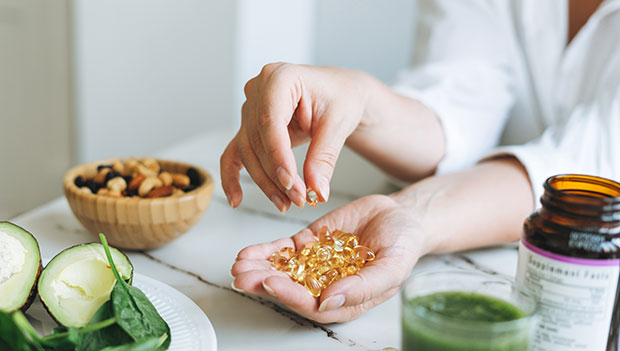
Do you ever feel like there are so many different vitamins it's difficult to know everything about all of them? Well, vitamin A is critically important in your body, so here we're breaking down what vitamin A is, what it does, and how it works in your body to promote good health and athletic performance.
What is Vitamin A Good For?
Like all vitamins, vitamin A has a number of functions in the body. Vitamin A helps form healthy teeth, bones, soft tissue, skeletal tissue, mucous membranes, and skin. Vitamin A also promotes good vision, particularly night vision, and is necessary for growth, development, tissue repair, cellular communication, and immune system functioning, as well as the formation and maintenance of several organs, including the heart, lungs, and kidneys.
What Foods Are High in Vitamin A?
Vitamin A isn't actually a single compound. Instead, vitamin A refers to a group of fat-soluble retinoids including retinol, retinal, and retinyl esters.
Two types of vitamin A are found in food, retinol, and retinyl ester. Both of these forms of vitamin A are considered preformed vitamin A. Retinol is found in animal liver, whole milk, and some fortified foods. Preformed vitamin A must be metabolized to the active forms of vitamin A in the body which are used to support biological functions. In the United States, the majority of vitamin A comes from preformed vitamin A in animal foods.
You've probably heard of beta-carotene. Beta carotene as well as alpha-carotene and beta-cryptoxanthin are the dark-colored pigments found in red palm oil and several fruits and vegetables, notably carrots, mango, cantaloupe, squash, sweet red bell peppers, seaweed, spinach, sweet potatoes, pumpkin, and some dark green leafy vegetables such as collards, kale, spinach, and Swiss chard. These carotenoids are converted to the active form of vitamin A in the body, a process that depends on several factors, including the food matrix (compounds that make up the food and the synergistic effect of these compounds), food processing, dietary fat intake, and genetics. Because of these factors, the conversion of carotenoids to vitamin A in the body can vary tremendously.
Beta-carotene is the most important carotenoid as more of it is converted to vitamin A then other carotenoids. Approximately 45 percent of the Western population are considered "low converters" of beta-carotene to the active form of vitamin A in the body. This can impact vitamin A levels over time if a large portion of vitamin A intake comes from carotenoids. For instance, a vegan who only consumes plant foods and does not consume any animal foods may have a lower amount of vitamin A in their body if they are a low converter of beta-carotene to the active form of vitamin A in the body.
If vitamin A sounds complicated, it is—like all nutrition. However, there are many easy ways to ensure you are eating a nutrient-rich diet. Also, consider pairing up foods for great taste and better nutrient bioavailability. As an example, consuming carotenoid-rich foods with a source of fat improves carotenoid bioavailability. For instance, you can eat carrots with peanut butter on them, salad with dressing, and roast butternut squash with some oil on it to improve carotenoid bioavailability.

Vitamin A Deficiency and Toxicity
In developed countries such as the United States, true vitamin A deficiency is rare, though sometimes seen in those with cystic fibrosis or in premature infants. However, this deficiency is common in developing countries where it is a leading cause of preventable blindness in children.
Because vitamin A is fat soluble, it is stored in the body, particularly in the liver. And therefore vitamin A can be toxic when taken in one large massive dose or when taken in large doses over time. A single large overdose of vitamin A can lead to very dry skin, inflammation and cracks at the corners of the mouth, gingivitis (gum disease), muscle and joint pain, fatigue, depression, and abnormal liver tests.
If high levels of vitamin A are taken chronically, this can lead to a number of symptoms including dizziness, blurred vision, vomiting, nausea, bone and muscle pain, headaches, and poor muscular coordination. Vitamin A toxicity can also cause liver damage that is not always reversible, coma, and death.
Although it is possible for excess dietary intake of vitamin A from food or supplements to lead to toxicity, most cases of vitamin A toxicity are from therapeutic retinoids (medicines prescribed in high doses for the treatment of acne, psoriasis, and other conditions). It takes a long time for tissue stores of vitamin A to decline after discontinuing the intake of therapeutic retinoids or preformed vitamin A.
Provitamin A carotenoids are considered nontoxic, though over a long period of time excess beta-carotene from dietary supplementation can lead to yellow-orange skin. Skin will return to its natural shade once beta-carotene intake is discontinued.
Because of the body's ability to store vitamin A and a lack of data on vitamin A status in athletes, there is no plausible reason to suggest athletes or fitness enthusiasts are more likely to be deficient in this vitamin. In addition, the data on vitamin A supplementation in athletes is insufficient to suggest supplementation is beneficial for performance or recovery, especially in the absence of deficiency.
Like all vitamins, vitamin A is crucial for overall health. It's also fairly easy to get in the diet because there are two options—beta carotene and other carotenoids in plant foods and preformed vitamin A in animal foods. Adding nutrient-packed foods to your diet is a surefire way to help you meet your needs. For reference, check out these 10 vitamin-packed foods that can help make it easier to ensure you are meeting your nutrient needs.


